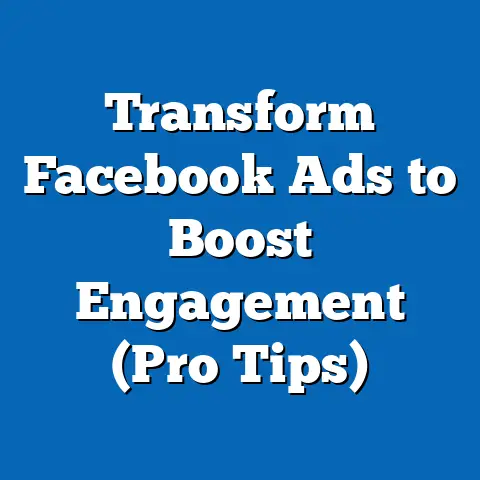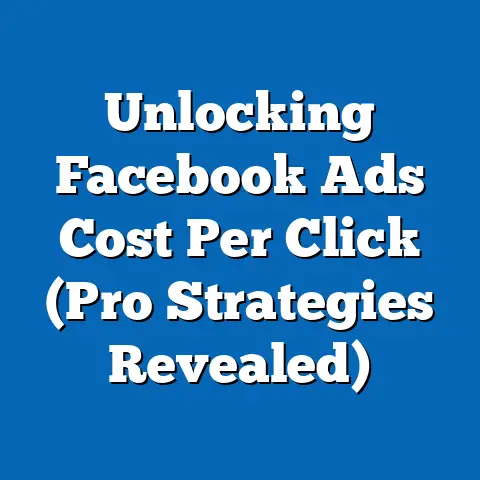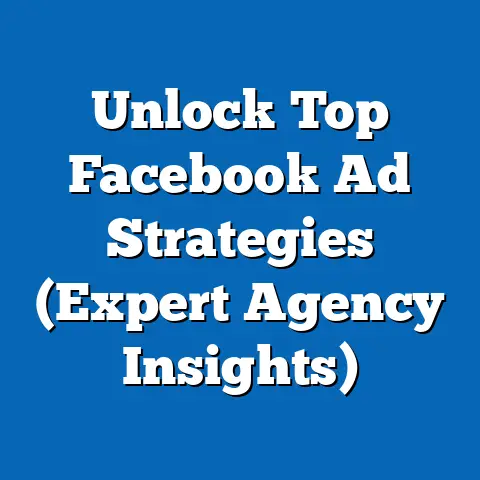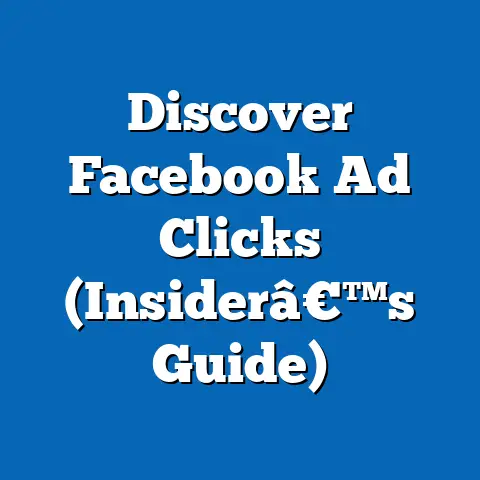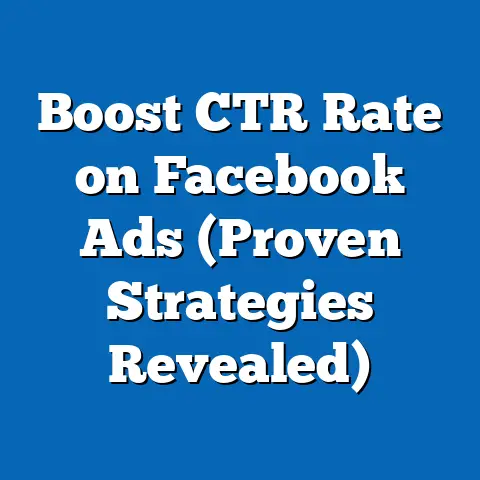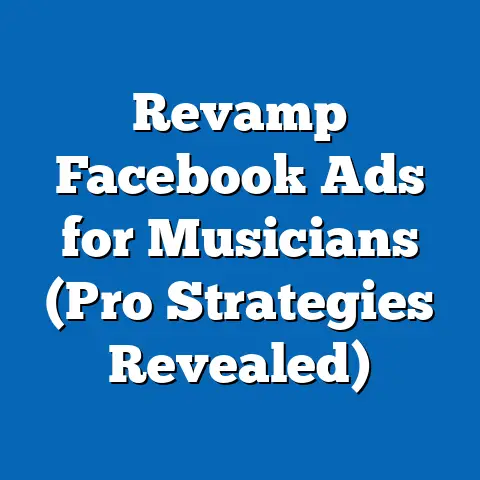Master Facebook Ads for Startups (Proven Strategies Revealed)
What if you could transform your startup from a small dream into a thriving business using the power of Facebook ads? That’s the question that fuels my passion for helping businesses like yours unlock the immense potential of this platform. I’ve spent years navigating the ever-changing landscape of Facebook advertising, and I’ve seen firsthand how a well-executed strategy can catapult a startup from obscurity to success. This guide is your roadmap to achieving that success, filled with proven strategies and actionable insights that you can implement today.
Understanding the Importance of Facebook Ads for Startups
In today’s digital marketing landscape, Facebook stands as a titan. It’s not just a social network; it’s a powerful advertising platform capable of reaching billions of potential customers worldwide. For startups, this reach is invaluable. I remember when I first started my own business, the thought of reaching a global audience felt like a distant dream. But Facebook ads made it a reality.
Here’s why Facebook Ads are crucial for startups:
- Massive Reach: With over 2.9 billion monthly active users, Facebook offers unparalleled reach. You can connect with a diverse audience, regardless of location, interests, or demographics.
- Granular Targeting: Facebook’s advanced targeting options allow you to laser-focus your ads on specific demographics, interests, behaviors, and even custom audiences. This means you can show your ads to the people most likely to be interested in your product or service.
- Cost-Effectiveness: Compared to traditional advertising methods, Facebook ads are incredibly cost-effective. You can start with a small budget and gradually scale your campaigns as you see results. This is particularly important for startups that are often operating on a shoestring budget.
- High Engagement: Facebook is a highly engaging platform where people spend a significant amount of time. By creating compelling ads that resonate with your target audience, you can capture their attention and drive meaningful engagement.
- Measurable Results: Facebook Ads Manager provides detailed analytics that allow you to track the performance of your campaigns in real-time. You can see exactly how many people are seeing your ads, clicking on them, and converting into customers. This data allows you to make informed decisions and optimize your campaigns for maximum ROI.
According to Statista, digital advertising spend is projected to reach \$626.86 billion in 2023, with social media advertising accounting for a significant portion of that. Facebook continues to be a dominant player in the social media advertising space, making it an essential platform for startups looking to reach a wider audience and drive growth.
Why Facebook Ads Over Other Platforms?
While there are many digital advertising platforms available, Facebook offers unique advantages for startups:
- Lower Barrier to Entry: Setting up and running Facebook ads is relatively straightforward, even for beginners. The platform provides a user-friendly interface and a wealth of resources to help you get started.
- Strong Community Building: Facebook is a social platform at its core. It allows you to build a community around your brand and engage with your customers on a personal level. This can lead to increased brand loyalty and word-of-mouth marketing.
- Versatile Ad Formats: Facebook offers a variety of ad formats, including image ads, video ads, carousel ads, and collection ads. This allows you to choose the format that best suits your product or service and your target audience.
- Integration with Other Tools: Facebook integrates seamlessly with other popular marketing tools, such as Google Analytics and email marketing platforms. This allows you to track your results across multiple channels and optimize your overall marketing strategy.
I’ve seen many startups try to spread their limited resources across multiple platforms, only to see minimal results. Focusing on Facebook allows you to concentrate your efforts and maximize your impact.
Key Takeaway: Facebook Ads offer startups a powerful and cost-effective way to reach a massive audience, target specific demographics, and drive meaningful engagement.
Next Step: Evaluate your startup’s current marketing strategy and consider how Facebook Ads can complement or replace existing efforts.
Setting Up Your Facebook Ads Account
Before you can start running Facebook ads, you need to set up an account. This process involves creating a Facebook Business Manager account, linking your Instagram account, and creating a Facebook Page. I remember when I first set up my Business Manager account, I was a little overwhelmed by all the options. But don’t worry, I’m here to guide you through the process step-by-step.
Step 1: Create a Facebook Business Manager Account
Facebook Business Manager is a central hub for managing your Facebook Pages, ad accounts, and other business assets. To create a Business Manager account:
- Go to business.facebook.com and click “Create Account.”
- Enter your business name, your name, and your work email address.
- Follow the prompts to provide additional information about your business.
- Once your account is created, you’ll need to verify your email address.
Step 2: Link Your Instagram Account
If your startup has an Instagram account, it’s important to link it to your Business Manager account. This will allow you to run ads on Instagram as well as Facebook. To link your Instagram account:
- In Business Manager, go to “Business Settings.”
- Click “Accounts” and then “Instagram Accounts.”
- Click “Add” and then “Connect Your Instagram Account.”
- Enter your Instagram username and password and click “Log In.”
Step 3: Create a Facebook Page
A Facebook Page is essential for running Facebook ads. It’s where people can learn more about your business, engage with your content, and ultimately become customers. To create a Facebook Page:
- In Business Manager, go to “Business Settings.”
- Click “Accounts” and then “Pages.”
- Click “Add” and then “Create a New Page.”
- Choose a category for your Page (e.g., Business or Brand, Community or Public Figure).
- Enter your Page name and category and click “Create Page.”
- Add a profile picture, cover photo, and other relevant information to your Page.
Understanding Facebook’s Advertising Policies
Before you start running ads, it’s crucial to understand Facebook’s advertising policies. These policies outline what types of ads are allowed on the platform and what types are prohibited. Violating these policies can result in your ads being disapproved or your account being suspended.
Some key points to keep in mind:
- Misleading or Deceptive Content: Don’t make false or misleading claims in your ads.
- Discriminatory Practices: Don’t target your ads based on discriminatory factors such as race, ethnicity, religion, or sexual orientation.
- Prohibited Content: Don’t promote illegal or harmful products or services, such as drugs, weapons, or hate speech.
- Personal Attributes: Don’t make assumptions about people’s personal attributes, such as their health or financial status.
I’ve seen startups get their accounts suspended for seemingly minor violations of Facebook’s policies. It’s always better to err on the side of caution and make sure your ads comply with all applicable rules.
Key Takeaway: Setting up your Facebook Ads account involves creating a Business Manager account, linking your Instagram account, and creating a Facebook Page. Understanding Facebook’s advertising policies is crucial to avoid getting your ads disapproved or your account suspended.
Next Step: Take the time to carefully review Facebook’s advertising policies and make sure your ads comply with all applicable rules.
Defining Your Target Audience
One of the most powerful features of Facebook Ads is its ability to target specific audiences. By defining your target audience, you can ensure that your ads are seen by the people who are most likely to be interested in your product or service. I’ve seen startups achieve incredible results simply by refining their targeting and focusing on the right audience.
Identifying Your Ideal Customer
Before you can start targeting your ads, you need to identify your ideal customer. This involves understanding their demographics, interests, behaviors, and pain points.
Here are some questions to consider:
- Demographics: What is their age, gender, location, education level, and income?
- Interests: What are their hobbies, interests, and passions? What types of content do they consume online?
- Behaviors: What are their online shopping habits? What types of websites do they visit? What types of apps do they use?
- Pain Points: What problems are they trying to solve? What challenges are they facing?
Facebook’s Targeting Options
Facebook offers a variety of targeting options that allow you to reach your ideal customer:
- Demographic Targeting: Target people based on their age, gender, location, education level, and other demographic factors.
- Interest Targeting: Target people based on their interests, hobbies, and passions.
- Behavior Targeting: Target people based on their online shopping habits, website visits, and app usage.
- Custom Audiences: Create custom audiences based on your existing customer data, such as email lists or website visitors.
- Lookalike Audiences: Create lookalike audiences based on your existing customer data. These are people who share similar characteristics with your best customers.
I often recommend that startups start with a broad target audience and then gradually refine their targeting based on the results they see. This allows you to learn more about your audience and identify the most effective targeting options.
Using Audience Insights and Facebook Analytics
Facebook Audience Insights and Facebook Analytics are powerful tools that can help you learn more about your target audience. Audience Insights provides data on the demographics, interests, and behaviors of people who are connected to your Facebook Page or who are in your target audience. Facebook Analytics provides data on how people are interacting with your website and app.
By using these tools, you can gain valuable insights into your target audience and refine your targeting accordingly.
Key Takeaway: Defining your target audience is crucial for the success of your Facebook ad campaigns. Use Facebook’s targeting options, Audience Insights, and Facebook Analytics to learn more about your audience and refine your targeting accordingly.
Next Step: Create a detailed profile of your ideal customer, including their demographics, interests, behaviors, and pain points.
Crafting Compelling Ad Copy and Creative
Even with the most precise targeting, your ads will fall flat if your ad copy and creative are not compelling. This is where your understanding of your target audience truly shines. You need to speak their language, address their needs, and capture their attention with visually appealing content. I’ve seen startups with limited budgets create incredibly effective ads simply by focusing on crafting compelling ad copy and creative.
Writing Persuasive Ad Copy
Your ad copy should be clear, concise, and persuasive. It should highlight the benefits of your product or service and address the pain points of your target audience.
Here are some tips for writing effective ad copy:
- Use a strong headline: Your headline is the first thing people will see, so it needs to grab their attention.
- Highlight the benefits, not just the features: Focus on how your product or service will improve people’s lives.
- Use a call to action: Tell people what you want them to do (e.g., “Shop Now,” “Learn More,” “Sign Up”).
- Keep it short and sweet: People have short attention spans, so get to the point quickly.
- Use a conversational tone: Write like you’re talking to a friend.
Creating Eye-Catching Visuals
Visuals are just as important as ad copy. They should be high-quality, relevant to your product or service, and visually appealing.
Here are some tips for creating effective visuals:
- Use high-quality images and videos: Don’t use blurry or pixelated images.
- Use bright colors and bold fonts: Make your visuals stand out.
- Showcase your product or service in action: Let people see how it works.
- Use lifestyle imagery: Show people using your product or service in real-life situations.
- Keep it simple: Don’t overcrowd your visuals with too much information.
Examples of Successful Startup Ads
To inspire you, here are some examples of successful ad copy and visuals from startups:
- Example 1: A clothing startup
- Headline: “Finally, Comfortable and Stylish Clothing for Women”
- Body: “Our clothing is made from high-quality materials that are designed to fit and flatter your figure. Shop our collection today and experience the difference!”
- Visual: A lifestyle image of a woman wearing the clothing in a real-life situation.
- Example 2: A software startup
- Headline: “The Easiest Way to Manage Your Projects”
- Body: “Our software helps you stay organized, collaborate with your team, and track your progress. Sign up for a free trial today!”
- Visual: A short video demonstrating the software in action.
- Headline: “Finally, Comfortable and Stylish Clothing for Women”
- Body: “Our clothing is made from high-quality materials that are designed to fit and flatter your figure. Shop our collection today and experience the difference!”
- Visual: A lifestyle image of a woman wearing the clothing in a real-life situation.
- Headline: “The Easiest Way to Manage Your Projects”
- Body: “Our software helps you stay organized, collaborate with your team, and track your progress. Sign up for a free trial today!”
- Visual: A short video demonstrating the software in action.
I’ve seen startups achieve incredible results by using user-generated content in their ads. This involves showcasing photos or videos of real customers using your product or service. This type of content is often more authentic and relatable than traditional advertising.
Key Takeaway: Crafting compelling ad copy and creative is essential for capturing the attention of your target audience and driving engagement. Use strong headlines, highlight the benefits of your product or service, and create eye-catching visuals.
Next Step: Brainstorm ideas for ad copy and visuals that will resonate with your target audience.
Budgeting and Bidding Strategies
Determining an appropriate budget for Facebook ads can be a challenge, especially for startups with limited resources. The key is to start small, test different budgets, and gradually scale your campaigns as you see results. I’ve seen startups waste a lot of money by setting unrealistic budgets or using ineffective bidding strategies.
Determining an Appropriate Budget
There’s no one-size-fits-all answer to the question of how much to spend on Facebook ads. The appropriate budget will depend on a variety of factors, including your industry, target audience, and campaign objectives.
Here are some guidelines to consider:
- Start small: Begin with a small daily budget (e.g., \$5-\$10) and gradually increase it as you see results.
- Test different budgets: Run multiple campaigns with different budgets to see which one performs best.
- Consider your ROI: Make sure your advertising spend is generating a positive return on investment.
- Factor in your customer lifetime value: If you have a high customer lifetime value, you can afford to spend more on acquiring new customers.
Understanding Bidding Strategies
Facebook offers a variety of bidding strategies that allow you to control how much you pay for your ads. The right bidding strategy will depend on your campaign objectives and your budget.
Here are some common bidding strategies:
- Cost Per Click (CPC): You pay each time someone clicks on your ad. This is a good option if your goal is to drive traffic to your website.
- Cost Per Mille (CPM): You pay for every 1,000 impressions your ad receives. This is a good option if your goal is to increase brand awareness.
- Cost Per Action (CPA): You pay each time someone takes a specific action, such as making a purchase or signing up for a newsletter. This is a good option if your goal is to generate leads or sales.
I typically recommend that startups start with a CPC or CPM bidding strategy and then gradually transition to a CPA bidding strategy as they gather more data.
Testing Budgets on Small Campaigns
Before you scale your campaigns, it’s important to test different budgets on small campaigns. This will allow you to see which budgets generate the best results and optimize your campaigns accordingly.
Here are some tips for testing budgets on small campaigns:
- Run multiple campaigns with different budgets: This will allow you to compare the performance of different budgets side-by-side.
- Track your results carefully: Monitor your key metrics (e.g., CTR, conversion rate, ROI) to see which budgets are generating the best results.
- Adjust your budgets accordingly: Based on your results, increase or decrease your budgets as needed.
Key Takeaway: Determining an appropriate budget and choosing the right bidding strategy are crucial for maximizing your ROI on Facebook ads. Start small, test different budgets, and gradually scale your campaigns as you see results.
Next Step: Determine your startup’s ideal customer lifetime value and use this information to inform your budgeting decisions.
Launching Your First Ad Campaign
Now that you’ve set up your account, defined your target audience, crafted compelling ad copy and creative, and determined an appropriate budget, it’s time to launch your first ad campaign. This can be an exciting but also daunting step. I remember the nervous energy I felt before launching my first campaign, wondering if all my preparation would pay off.
Setting Clear Objectives and KPIs
Before you launch your campaign, it’s important to set clear objectives and key performance indicators (KPIs). This will allow you to track your progress and measure the success of your campaign.
Here are some common objectives for Facebook ad campaigns:
- Increase brand awareness: Get your brand in front of as many people as possible.
- Drive traffic to your website: Get people to visit your website and learn more about your products or services.
- Generate leads: Collect contact information from potential customers.
- Drive sales: Get people to purchase your products or services.
Here are some common KPIs for Facebook ad campaigns:
- Click-Through Rate (CTR): The percentage of people who click on your ad.
- Conversion Rate: The percentage of people who take a desired action (e.g., make a purchase, sign up for a newsletter).
- Return on Investment (ROI): The amount of money you make for every dollar you spend on advertising.
Choosing the Right Ad Format
Facebook offers a variety of ad formats that you can use to reach your target audience. The right ad format will depend on your campaign objectives and your target audience.
Here are some common ad formats:
- Image Ads: Simple ads that consist of an image and some text. These are a good option for increasing brand awareness or driving traffic to your website.
- Video Ads: Ads that consist of a video. These are a good option for showcasing your product or service in action or telling a story about your brand.
- Carousel Ads: Ads that consist of multiple images or videos that people can scroll through. These are a good option for showcasing multiple products or services or telling a story about your brand in a visual way.
- Collection Ads: Ads that consist of a collection of products that people can browse and purchase. These are a good option for driving sales.
I often recommend that startups experiment with different ad formats to see which one performs best for their target audience.
Step-by-Step Guide to Launching Your Campaign
Here’s a step-by-step guide to launching your first Facebook ad campaign:
- Go to Facebook Ads Manager.
- Click “Create.”
- Choose your campaign objective.
- Define your target audience.
- Set your budget and bidding strategy.
- Choose your ad format.
- Create your ad copy and visuals.
- Review your campaign settings.
- Click “Publish.”
Key Takeaway: Launching your first ad campaign involves setting clear objectives and KPIs, choosing the right ad format, and following a step-by-step guide.
Next Step: Choose a specific objective for your first campaign (e.g., driving traffic to your website) and identify the KPIs you will use to measure its success.
Monitoring and Analyzing Ad Performance
Once your ad campaign is launched, it’s crucial to monitor its performance and analyze the results. This will allow you to identify what’s working and what’s not, and make data-driven decisions to optimize your campaign for maximum ROI. I’ve seen startups transform failing campaigns into successful ones simply by paying close attention to the data and making adjustments accordingly.
Tracking Key Metrics
Facebook Ads Manager provides a wealth of data that you can use to track the performance of your campaigns. Some key metrics to monitor include:
- Impressions: The number of times your ad was shown.
- Reach: The number of unique people who saw your ad.
- Click-Through Rate (CTR): The percentage of people who clicked on your ad.
- Conversion Rate: The percentage of people who took a desired action (e.g., make a purchase, sign up for a newsletter).
- Cost Per Click (CPC): The amount you paid for each click on your ad.
- Cost Per Conversion (CPC): The amount you paid for each conversion.
- Return on Ad Spend (ROAS): The revenue you generated for every dollar you spent on advertising.
Interpreting the Data
Once you’ve tracked your key metrics, it’s important to interpret the data and understand what it means. For example, if your CTR is low, it could mean that your ad copy or visuals are not compelling. If your conversion rate is low, it could mean that your landing page is not optimized for conversions.
Here are some tips for interpreting the data:
- Compare your results to your benchmarks: Are your results better or worse than your industry benchmarks?
- Look for trends: Are your results improving or declining over time?
- Segment your data: Look at your results by demographics, interests, and behaviors to see which segments are performing best.
Making Data-Driven Decisions
Based on your analysis of the data, you can make data-driven decisions to optimize your campaign for maximum ROI. For example, if you find that your CTR is low, you could try testing different ad copy or visuals. If you find that your conversion rate is low, you could try optimizing your landing page.
Here are some tips for making data-driven decisions:
- Test one variable at a time: This will allow you to isolate the impact of each variable.
- Track your results carefully: Monitor your key metrics to see how your changes are affecting your performance.
- Be patient: It takes time to optimize a campaign, so don’t get discouraged if you don’t see results immediately.
I’ve seen startups achieve incredible results by using A/B testing to optimize their ad copy and visuals. This involves creating two versions of an ad and showing them to different segments of your audience to see which one performs best.
Key Takeaway: Monitoring and analyzing ad performance is crucial for identifying what’s working and what’s not, and making data-driven decisions to optimize your campaign for maximum ROI.
Next Step: Set up a system for tracking your key metrics and analyzing your results on a regular basis.
Scaling Successful Campaigns
Once you’ve launched a successful Facebook ad campaign, the next step is to scale it. This involves increasing your budget, expanding your reach, and attracting similar users. I’ve seen startups experience exponential growth by effectively scaling their successful ad campaigns.
Strategies for Scaling
Here are some strategies for scaling successful Facebook ad campaigns:
- Increase your budget: Gradually increase your budget as you see results.
- Expand your reach: Target new audiences that are similar to your existing audience.
- Use lookalike audiences: Create lookalike audiences based on your existing customer data.
- Test new ad formats: Experiment with different ad formats to see which one performs best for your target audience.
- Retarget website visitors: Show ads to people who have visited your website but haven’t yet made a purchase.
Using Lookalike Audiences
Lookalike audiences are a powerful tool for expanding your reach and attracting similar users. They allow you to target people who share similar characteristics with your best customers.
To create a lookalike audience, you’ll need to provide Facebook with a source audience, such as your existing customer list or your website visitors. Facebook will then analyze the characteristics of this source audience and create a new audience that is similar to it.
I’ve seen startups achieve incredible results by using lookalike audiences based on their existing customer data. This allows them to reach a wider audience of people who are likely to be interested in their products or services.
Maintaining Ad Performance While Scaling
Scaling a successful ad campaign can be challenging. It’s important to maintain ad performance while increasing your budget and expanding your reach.
Here are some tips for maintaining ad performance while scaling:
- Monitor your key metrics closely: Keep a close eye on your key metrics (e.g., CTR, conversion rate, ROI) to see how your changes are affecting your performance.
- Adjust your targeting as needed: As you scale your campaign, you may need to adjust your targeting to ensure that you’re still reaching the right audience.
- Test new ad copy and visuals: Continue to test new ad copy and visuals to see which ones perform best for your target audience.
- Be patient: It takes time to scale a campaign successfully, so don’t get discouraged if you don’t see results immediately.
Key Takeaway: Scaling successful campaigns involves increasing your budget, expanding your reach, and attracting similar users. Use lookalike audiences to expand your reach and maintain ad performance while scaling.
Next Step: Identify your most successful ad campaigns and develop a plan for scaling them.
Conclusion
Facebook Ads offer an incredible opportunity for startups to reach a massive audience, drive traffic to their websites, generate leads, and drive sales. By following the strategies outlined in this guide, you can master Facebook advertising and use it as a key component of your growth strategy. Remember that success in advertising is a journey of continuous learning and adaptation. Experiment with different strategies, track your results, and make data-driven decisions to optimize your campaigns for maximum ROI.
I encourage you to take actionable steps today to implement these strategies and unlock the potential of Facebook advertising for your startup. The journey may have its challenges, but the rewards of a well-executed Facebook ad strategy can be transformative. So, dive in, experiment, learn, and watch your startup flourish!

